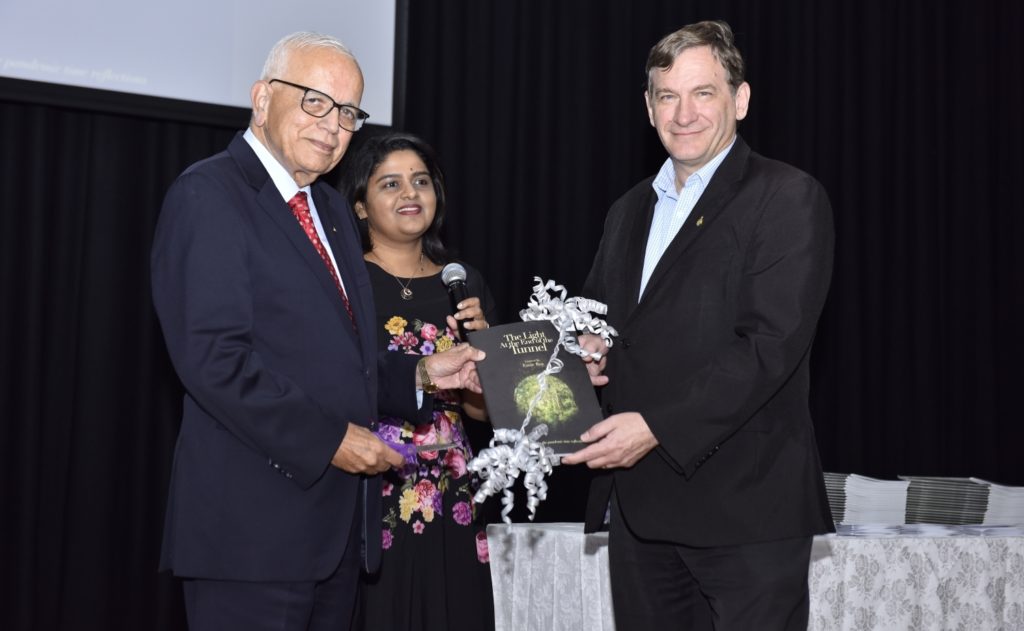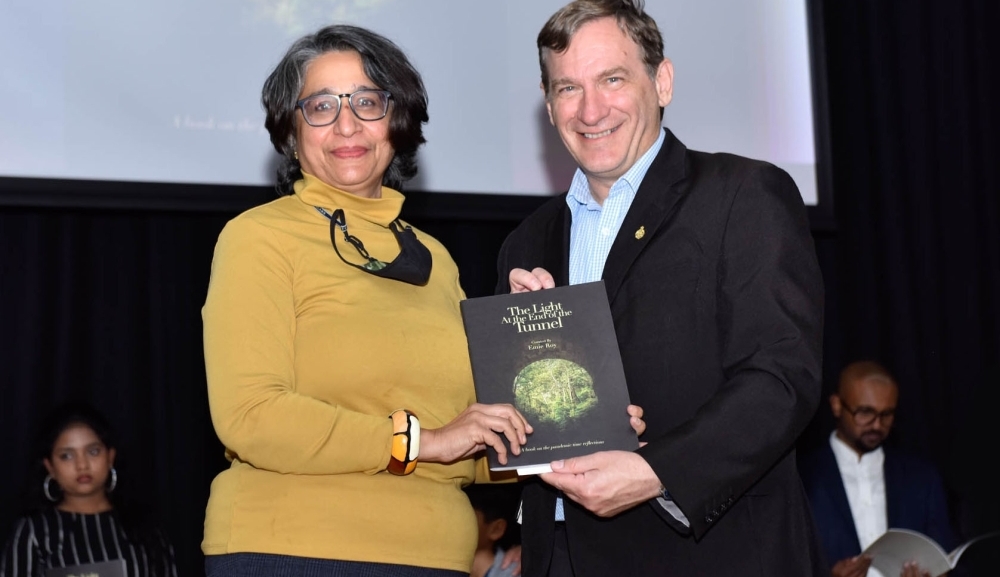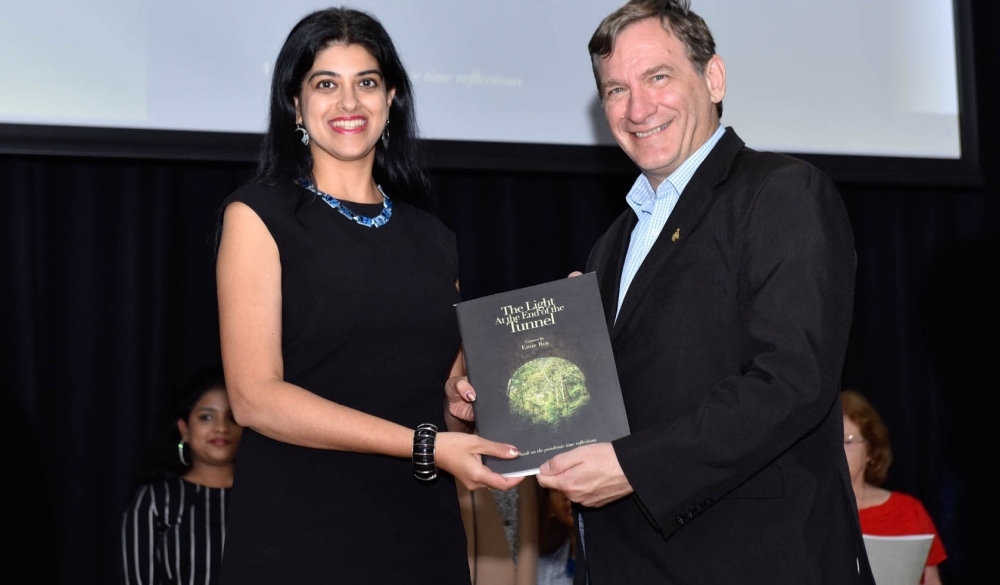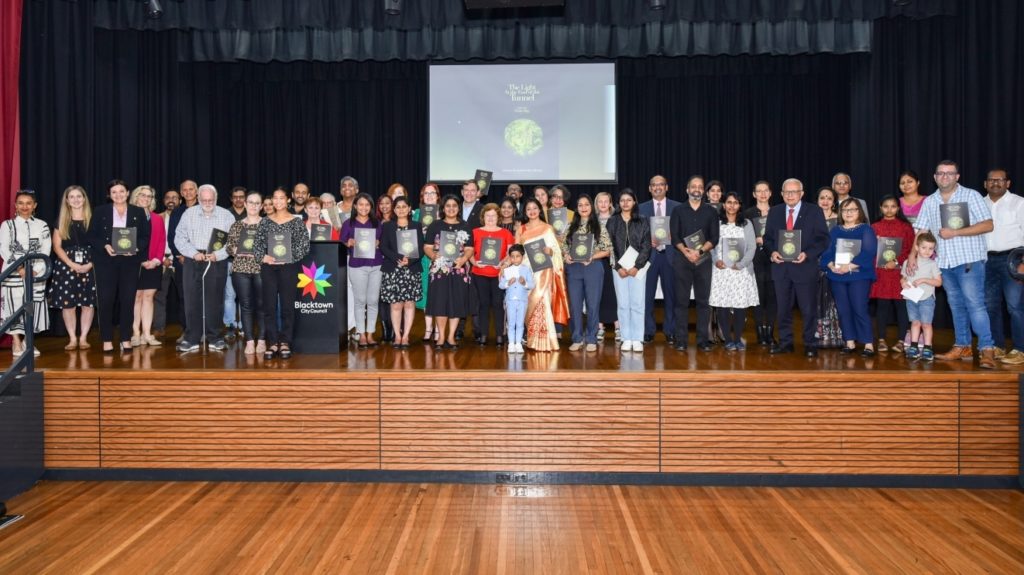‘The Light at the end of the tunnel came from within’, says Emie Roy, the curator

By Neena Badhwar
The book ‘The Light At the End of the Tunnel’ published by Emie Roy as the curator, a work that kept her busy for close to a year, with stories compiled from fifty individuals describe the survival spirit of ordinary human beings during Covid. People suddenly were caught off guard with the pandemic that has been described as one-in-a-century event, rather an event that took millions of lives, causing innumerable suffering for the families worldwide who lost their near and dear ones.
Australia faced its own difficult period as essential workers such as doctors, nurses in hospitals trying their best to save lives, para medical staff and people working hard in various fields had to adjust and readjust to the lock ups and still carry on with their jobs. Many switched to working from homes, teachers teaching students online, daily life of every day citizens turned upside down with governments’ strict measures instituted to stop Covid -19 from spreading. It was a difficult time for all.
Reflections by the people in the book describe heartache, tears of sadness, tears of joy even to see the little bundle when pregnant women had to manage labour on their own without the husbands on their side; a doctor describing the ordeal of operating on a 96-year-old patient with Covid; some wrote journals on how they felt; others trying to dodge catching Covid while commuting to work. Many took up hobbies, walking, cycling, music, yoga to keep their minds off, having been locked up and cooped in apartments for months. They are heart rending stories and thoughts shared in this beautifully presented book which depict how we all felt and did to survive and are carrying on as the specter of Covid still looms large around us.

The book was launched in early May by the Blacktown City Council Library at the Bowman Hall, Blacktown conducted in the presence of MP Blacktown Stephen Bali, politicians Julia Finn and Jodi McKay, officials from Multicultural NSW, Blacktown City Council, CMRC and Westpoint and, of course, Emie Roy, her creative team and the writers.

TIDU talked to Emie Roy, here she says how she found her own light at the end of tunnel rather from within while she worked on the book, which turned into an exercise of meditation as she read each story that got submitted:
Q. 1. ‘Light at the End of the Tunnel’, Emie, you have turned experiences in the book choosing 50 ordinary Australians from various walks of life – putting together doctors, teachers, essential workers, volunteers, writers, poets, house-wives, accounting their stories through the two years of Covid-19? How did the idea begin? How did you go selecting the people included?
Emie: We live in a historically significant period of time. Every human being on this planet has been impacted by the pandemic. As everyone else, I have been listening to a lot of stories in relation to how people were impacted, in the last couple of years. Stories that are poignant, stories of desperation, suffering, pain, anger, hope, kindness and rarely, funny ones. I feel like I have never listened to any one’s stories so keenly at any point in my life.
I wanted to capture at least a few of these stories, in reference to this unique period we live in, which is how it all began. When Blacktown City council, Community Migrant Resource Centre and Westpoint came onboard, the idea took life.
Fifty was the magic number I aimed for, and I am so glad we could publish 50 stories in the end. The number was decided on after I scoped the project, estimated the budget and evaluated the time in my hands.
It was not easy bringing together 50 stories though. The council did a media release calling out for stories, and promoted the same. I spread the word by writing and speaking to many organizations, sought stories through various social media groups. Many individuals and newspapers reshared the posts. The community warmed up to the idea, people even reached out to suggest their acquaintances whose stories would be a good fit. Organizations like the Community Migrant Resource Centre and SydWest Multicultural Services also referred stories to me. I kept an eye out for stories. I approached some people who I knew had very poignant experiences. Many stories came in organically. A few people responded to my request, and a few others were referred to me. There were a few who started writing, but couldn’t finish. Some people found value in the project, but had hesitation on sharing a personal story. I respected that. It is their life, and it was perfectly fine for them to decide not to share it. Sometimes, people who committed couldn’t fulfill it because life took over. I had to politely say no to some, because the stories had to be different. Sometimes, I had 50 odd stories in train, and at other times, less than 50. Eventually, I hit the magic number – 50!



Q2. How have the stories helped you in the process of how you felt in these very exceptional yet trying two-and-a-half years?
Emie: It was very pacifying, to say the least. Someone said to me that besides being a record of the Covid times, this book could potentially help people dealing with anxiety and depression when they see how we lived through these times. I must say that it is something I experienced myself. I used to get up early in the morning to edit one story a day, during the times of lockdown in 2021. As days progressed, I realised that the exercise was helping me like meditation. Every single day, I was connecting to a fellow human being who persevered and pulled through – and it was helping me to be very optimistic and hopeful about the whole situation.
It took me 10 months to bring out the book. Once the editing process was completed, I felt that every time I thought about the book, a warmth settled within me.
Q3. The stories while they motivate the survival spirit of individuals, they at the same time describe the period even accepting that it was once-in-a-lifetime and most difficult period of their lives. Depression, mental issues surfacing during the period, describe confusion all around, but then most coming out stronger at the end of it all?
Emie: Exactly – I think that is the beauty of it! When people told me their stories, however difficult they felt it was, I realised that they were all survivors at the end of the day. They had coped much, and survived the most difficult period of their lives, which was what I wanted to emphasise in the book. The best depiction of which is the title itself – “The Light at the end of the Tunnel”.
Compiling fifty stories together was going to illustrate how we collectively survived, which would be a valuable document in the years to come.
Q4. The book is very well designed with interesting graphics and images? What do you say?
Emie: Thanks! I can guarantee that a lot of thought has gone into the book and feel of the book. I used some of the images supplied by the authors, however most are original photographs taken by the photographers in Sydney. While curating the images, I made sure that they connect with the narrative, at the same time, I tell a story of their own.
Talking about the graphics, the colours we chose were of much importance. We had powerful stories, and then we had images. The graphics had to compliment these, instead of having a different identity of their own. The colours used also had to tie in with the theme of the book. The last thing I wanted to do was to make a book that depicts confusion, instead it had to manifest the spirit of positivity which is what the book was trying to speak of; hence I decided on soothing, natural colors in the design that go easy on eyes – shades of brown soil, green leaves and cloudy gray sky in the design of the book. Today, when people say that they find it calming to look at the book and read the survival stories, it’s very gratifying.
There are a couple of anecdotes I would like to mention here –
– I recollect that my first trip outside my LGA once the lockdown was lifted was to my graphic designer’s office, to discuss the book.
– The cover pic was taken by the photographer, who went on a trip to Blue Mountains solely for this purpose, after being briefed about the theme of the book.
Q5. We hope these stories motivate people and help others giving various strategies in not only coping with Covid but also be able to face other challenges that the humans face eg. Cost of living, Housing, Climate Change in the form of unpredictable weather patterns such as floods, rains, hot weather etc. It seems to be the new way of living for all? Can you sum up some of the take away clues to the survival strategies by you learnt from the project?
Emie: Many writers told me that writing their story down helped them reflect on things – to reevaluate their lives, and what they have been through. Re-living all that in words, it made them realize that they are now in a much better place than they thought they were. They are also grateful making it part of a story-collective has given their story the potential to inspire fellow human beings for many generations to come.
To me, personally, a crucial survival strategy I learnt from the project that, even though we were thrown in the deep end, we did not perish with it. Instead, we stopped, reflected and retreated, which helped the human spirit to eventually shine through. The most important thing is that instead of waiting for the light at the end of the tunnel to flash upon us, we learnt to seek it from within.
Q6. How has the response been from the book?
Emie: I am humbled that there has been excellent response from all over. To start with, the contributors, supporters, my co-editor, designer – everyone is happy with the way the book came out. I have heard very kind and generous words being said by the broader community of readers and beneficiaries which I am very thankful for.
Q 7. Would you be considering further compilation such as this, a Volume 2 of ‘the Light At The End of The Tunnel’?
Emie: Certainly, I am open to the idea. I have a storytelling ensemble, The Stories Untold (http://thestoriesuntold.com.au/), under the banner of which I produced this book. The whole purpose of this platform is to bring out stories that have been untold, in print, audio and visual forms.
I had to invest 10 solid months of work in it, and to work with a budget, with ample support from three organisations – Blacktown City council, Community Migrant Resource Centre and Westpoint.
If there is further interest in the compilations, support can be garnered and I would be delighted to invest my time and energy into more volumes. After all, stories are what keep us going.
Short URL: https://indiandownunder.com.au/?p=17910
